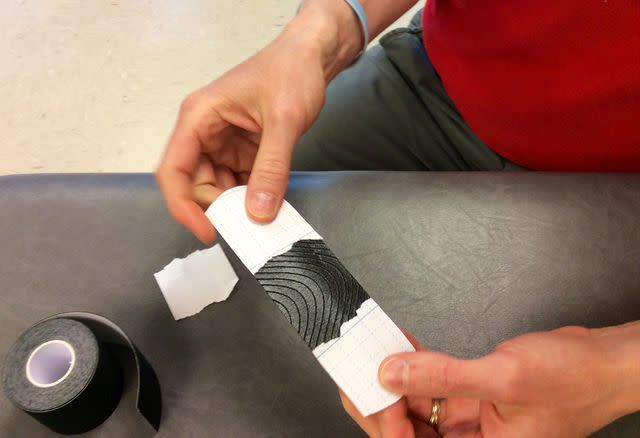Release Neck & Shoulder Knots With Kinesiology Tape
Medically reviewed by Eva Umoh Asomugha, M.D.
Kinesiology tape, known also as KT, can be a powerful tool in helping release knots in the neck and shoulder blades. The upper trapezius and levator scapula muscles make up the part of your shoulder where your neck and shoulder meet. These pesky trigger points can cause pain, tension, and muscular spasms in your neck and shoulders.

Proposed treatments for releasing trigger points in your shoulder blades include ultrasound, interferential current, TENS therapy, massage, and exercise therapy. Kinesiology tape is promising as a treatment as well.
This article will discuss the role of kinesiology tape in helping to release neck and shoulder pain and review how to apply KT.
What Is Kinesiology Tape?
Kinesiology tape is a type of physical therapy treatment that can be used in many ways. It can help to improve muscular contractions, decrease swelling, and inhibit pain in injured tissues.
Kinesiology tape can help lift the skin away from underlying tissues, which can help increase circulation and release muscular spasms. This may help decrease the trigger points and knots in your upper trapezius and levator muscles when you have neck pain.
Applying KT to the Shoulder and Neck
You can use a specific type of kinesiology tape strip called a lift strip to decrease trigger points in your upper traps and levator muscles. Be sure to review the various types of strips to learn how to cut the lift strip properly.
Before using kinesiology tape, consult your healthcare provider or physical therapist to assess your injury and situation. Kinesiology tape is not for everyone, and some people have conditions where the use of kinesiology tape should be avoided altogether. Your PT can evaluate your neck pain and trigger points to determine if you should use kinesiology tape for your condition.
This is how you use kinesiology tape to decrease spasms and trigger points in your upper shoulders and neck:
Sit comfortably with your neck and shoulders exposed.
Cut one lift strip for each side of your neck, if needed. The lift strip should be about 3 to 4 inches long.
Remove the paper backing in the center part of each strip. The exposed tape in the center should make the strip look like an adhesive bandage. Both ends of the lift strip should still have the paper backing on.
Fully stretch the kinesiology tape.
Place the stretched tape directly over your trigger points in your upper shoulder area.
Remove the backing on either side of the lift strip and apply the ends on your skin with no stretch.
Gently rub the kinesiology tape to help the adhesive adhere to your skin.
Once the tape has been applied, leave it there for 2 to 5 days. It can get wet. Monitor your skin around the tape to watch for redness or other signs of an adverse reaction to the adhesive.
Does KT Work for Shoulder Blade Knots?
Using KT for releasing trigger points in the upper trapezius and levator muscles has been studied with some evidence that it can help, especially when used with physical therapy and other treatments. However, more rigorous studies need to be done to understand the extent to which KT can help with pain and healing.
While kinesiology taping may be a valuable tool to decrease pain and spasms, it does not replace active exercises and postural correction for the treatment of your neck and shoulder pain. Be sure your physical therapist teaches proper self-care strategies for your specific condition.
If you have neck pain and muscle spasms in your upper shoulders, a trial of kinesiology taping may help decrease your pain and improve your overall condition.
Summary
Although more research needs to be done, the use of kinesiology tape in relieving shoulder blade knots is a promising area, and a low-risk intervention that some people find quite useful. It is most effective when used with physical therapy, range of motion and strengthening exercises, and other treatments like ultrasound and electrical stimulation.
Read the original article on Verywell Health.
